|
II.
|

|
The Germans have achieved some of their greatest successes in the art of figure painting with
subjects derived from that legendary lore in which their country is so rich. Among the artists
whom this world of phantoms has enchanted, probably the foremost is William Kray. he is no
stranger to the art lovers of America, for his paintings have long been popular in this country,
and are to be found in most of our prominent private collections. He was born in Berlin, and
began his studies there, afterward residing for a long time in Rome and Venice. Ultimately he
returned to Germany and ssettled in Vienna, where he speedily won distinction. In
"The Dance of the Will o' the Wisps" he renders a poetic version of the old legend of the wildfires,
the gleaming spirits of marsh and fen.
|
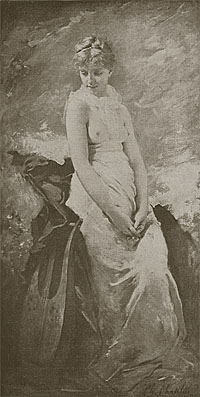
|
The late Charles Chaplin was born at Andelys,
in the Department of the Eure, France, of an English father and a French mother, in 1825.
At the age of fourteen he became a pupil of the painter Drolling in Paris, and settled in
Auvergne to become a landscape painter. But the figure had an irresistible attraction for
him, and like Kray, who also commenced by painting landscapes, he gradually abandoned his
first choice of pursuit for the nobler and more enticing one. His
success as a painter of portraits, and especially of portraits of women, continued until his death.
Meanwhile he painted many imaginative compositions, in the coquettish and seductive style of
Boucher, to which class "The Lyre" belongs,
and executed decorative work for great mansions and palaces, especially for the Tuileries, the
Elysee, etc. Chaplin died, very rich, two years ago. He had been an Officer of the Legion of
Honor since 1877.
|
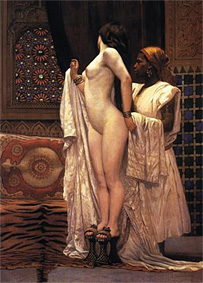
|
P.L. Bouchard is a French artist, of what some critic has classified as the
School of Gerome. He is a Parisian, and made his studies at the Ecole des beaux Arts in the
class over which M. Gerome exercised direction. In "After the Bath" he shows the interior of
a bathing room, where the favorite of the harem has been making her ablutions. M. Bouchard is,
as a draughtsman and colorist, and in his style of painting, one of the foremost of living French artists.
|

|
Some of the ablest of modern German painters have of late years turned their eyes to the Orient for
subjects, and among the most successful of these is E. Richter, of Berlin. He is a graduate of the
Munich Art Academy, and his renditions of the supple charms of the beauties of the harem have been
widely distributed by reproduction in various forms. In "At her Ease" he gives a
scene from the
Alhambra at Grenada, where he made many studies in the famous old palace of the Moorish kings,
which the Spanish Government preserves as a species of national monument. It is one of the queens
of the royal harem who awaits the coming of her lover. She stands in the doorway opening on a
balconied staircase, holding in her hand the rose, the flower of love, which has been sent her
as a token. In her splendid dress, enriched with costly jewels, her attitude and expression,
she affords a perfect picture of the refined type of voluptuous Oriental seductiveness. As a portrait
painter Richter enjoys an enviable reputation.
|
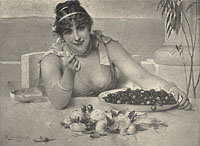
|
Leon Herbo is a Parisian, whose works are well known at the Salon exhibitions.
He was first presented to the public by ambitious compositions of the style usual to students of the
art schools, but presently began to make a reputation as a portrait painter. In the intervals of
his engagements in this department of art, he produced pictures of the manner of subject of
"Cherries and Roses," and as these found increasing favor, and secured him commissions for
the decorations of the mansions of wealthy Parisians, he gradually increased his productiveness
in this direction, and through it he is best known to the world at large.
|
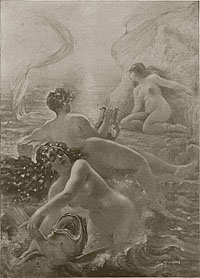
|
The old Greek legend
of the Sirens has attracted many artists, and resulted in the creation of many admirable pictures,
from races not dreamed of when Ulysses sailed upon his voyage in quest of the golden fleece.
In the composition of Adolphe La Lyre, who is an esteemed artist
of the modern school in Paris,
to which city he belongs, the tradition finds a quite original and individual interpretation.
La Lyre, a painter educated in the Bouguereau class at the Paris Art Academy, somewhat follows
his master in correct drawing and pure color, but has quite an indivudal style.
|

|
Like his twin brother, the distinguished artist Jean Benner, Emmanuel Benner commenced his life
as a designer for the mills and factories of Mulhouse in Alsace, where he was born in 1836.
At the age of thirty, having amassed some means by strict economy, he devoted himself entirely
to art, his masters in paitning being Eck, Henner, a fellow Alsatian; and Leon Bonnat. He at
first painted pictures of still life, portraits, and genre subjects, and commenced exhibiting
at the Salon in 1868. In 1875 he struck out in a new direction, and his masterly paintings of
the nude won him immediate favor. The character of his art has been sufficiently adverted to
in Part I. of this work. Benner won his first Salon medal in 1881, with a picture very similar
in character to "The Sleeper," which was entitled "Le Repos."
|
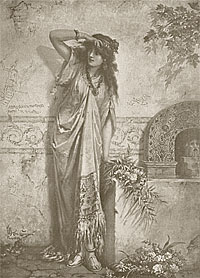
|
The late Joseph Coomans was one of the most popular of European painters
with American
collectors, and the sale of his works in this country alone made him a very rich man.
He was a native of Brussels, and a pupil of Professor Hasselaere
at Ghent, and of Nicaise de Keyser and Baron Wappers at the Antwerp Academy. From Antwerp he
removed to Paris, and going with the French army to Algiers, where he resided several years,
he later traveled extensively in Italy, Turkey, Greece, and the Crimea. At this time he painted
historical and portrait subjects, but in 1857 he visited Italy, and became interested in the
remains of ancient Pompeii, which were then being excavated. From this time forth he took up
the line of subjects which made him famous. He had two daughters, both of whom possessed
remarkable artistic gifts, and who, as his pupils, became well-known painters. Some
years before his death he visited America, residing here for a prolonged period, and his
daughters accompanied him and became favorites in the best New York society. Both
Miss Heva Coomans and her sister Diana [Coomans] paint the same class of objects as their father,
and very much in his manner and feeling of color. In "The Pompeiian Flower Girl" is presented
an extremely characteristic example of one talented daughter of a famous parent.
|
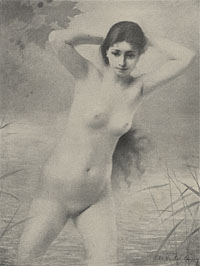
|
One of the younger Frenchmen [Edouard Michel Lancon] who have attracted attention at the great exhibitions is
the painter of "A Bather." He comes of artistic stock, at the head of which stood
the famous painter of animals and one of the greatest etchers the world has produced,
Auguste Lancon, and is a graduate of the Paris Art School.
|
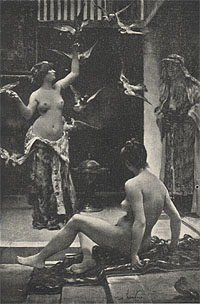
|
Another and much stronger man,
in whose death a few years ago French art sustained a serious loss, was Jules Arsene Garnier,
a Parisian, born in 1847. He commenced his studies at the Academy of Toulouse, one of the
best in Europe, painted
under J.L. Gerome in Paris, and travelled much in Holland, Spain, and Morocco, from which latter source his
"In the Harem" is derived.
|

|
Among the most eminent of French figure painters of the older school was
Charles Landelle, who was born at Laval, in Mayenne, in 1821, and was a pupil of Paul Delaroche and Ary Scheffer.
He never equalled either of his masters in power of expression, but
possessed a soft and pleasing style of his own. His life was extremely successful as a painter of easel
pictures, portraits, and decorative compositions, and examples of him are to be found in all the museums of
Paris and the departments
of France, and in many of the best American collections. The "Rebecca" is one of his pictures purchased
by the Government. Landelle was repeatedly medalled from 1842 down, and in 1855 was received into the
Legion of Honor for his picture "The Virgin Resting," which now hangs in the Louvre.
|
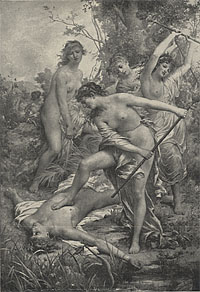
|
Of all the legends of classic antiquity that of Orpheus is, perhaps, the most contradictory. The painter
in this instance has adopted the most popular version. According to it, the son of Apollo and Calliope, having
been struck dead by a thunderbolt hurled by Zeus, as a punishment for revealing the divine mysteries,
his corpse is rejoiced over and spurned by the Thracian women, whose love, which he aroused by
the fascinations of his magic lyre, he had scorned. The artist, Francois Lafon, is the son of the well-known
painter Emile Jacques Lafon, born in 1817, who died in Paris in 1886. Francois Lafon was born in Paris and
was a pupil of his father, who hadbeen in his turn a student under Delaroche and Baron
Gros.
|
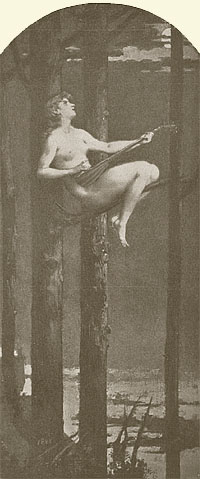
|
James Bertrand, who was born at Lyons, first studied there under Bonnefond, and later in paris
under Perin and Orsel, and at the Ecole des Beaux Arts. From Paris he went to Rome and painted many
Italian and religious subjects, with which he won his first medal in 1861. At the Salon of 1882 his
poetic rendition of the fable of the grasshopper was one of the pictures of the year.
|
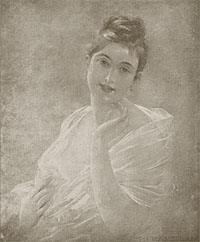
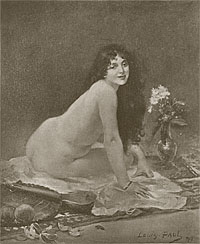
|
P. Franc Lamy
and Louis Paul, the painters respectively of "A Fantasy"
and "Harem Fruits and Flowers," belong to the
younger generation of modern French artists, whch has produced such strong representatives. The first named
has won honors at the Salon, where both are regular exhibitors.
|

|
Luis Falero is one of the most distinguished and original artists of our day. Although he has his studio in Paris,
he was born at Grenada in Spain, in 1851. He was intended for the Spanish
navy, and was carefully educated to that end in Madrid, England, and Paris. In "The Belated Witch" he gives a
fanciful episode of the old German legend that at certain periods the witches and warlocks hold a general holiday
or Sabbath among the Brocken Mountains. Here one of the accursed sisterhood, who has neglected her
opportunity to join the common parade to the rendezvous, sails out of a chimney on her journey alone, mounted
on her broomstick, the traditional steed of the sworn servitors of Satan.
|
|
|
|





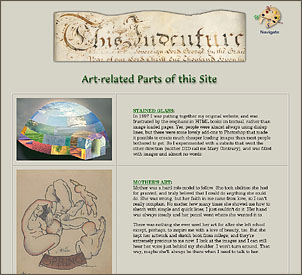



![]() Copyright © 2007, Mary S. Van Deusen
Copyright © 2007, Mary S. Van Deusen